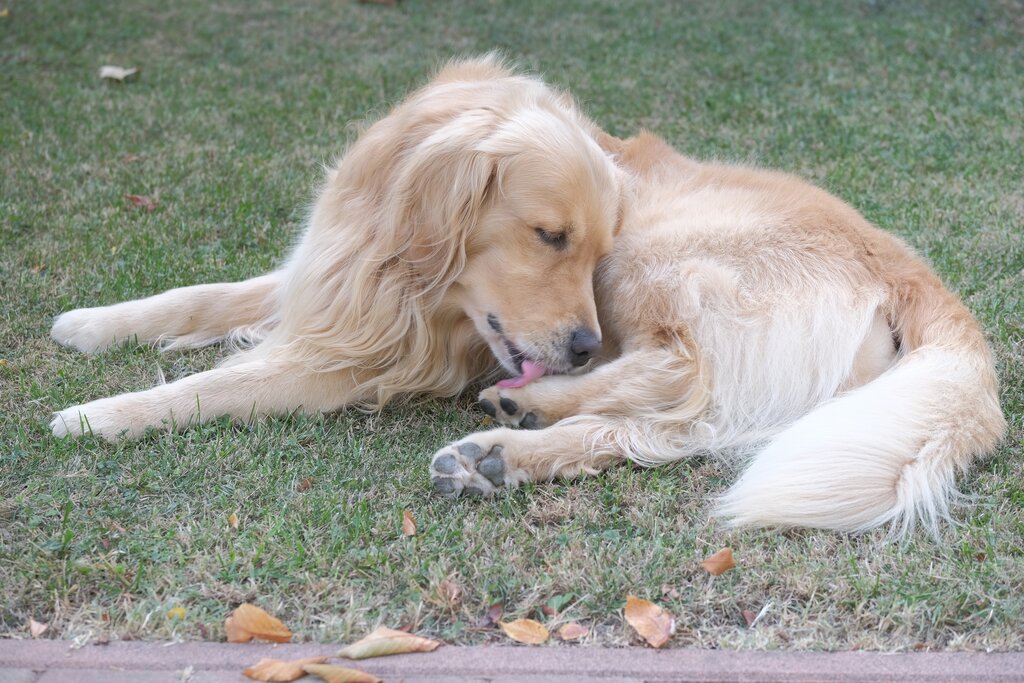07/27/2021
How to Prevent a Lick Granuloma

Is your dog always licking their paws or legs like they’re enjoying a popsicle?
While this behavior isn’t troubling at face value, it can be a sign of a larger problem. Your dog’s incessant licking of their paws and legs can have serious consequences, especially if they’re licking until their skin becomes raw and sore. This rawness and soreness is known as a lick granuloma. Luckily, this condition is treatable, allowing you to give your dog some much-needed relief.
What Is a Lick Granuloma?
A lick granuloma (also known as acral lick dermatitis) is a skin condition that occurs due to distress in your dog. This distress can be flared up by stress, anxiety, or boredom. When your dog is stressed, they will start to lick a patch of their skin over and over until it becomes raw. This can lead to a lesion that will appear red, irritated, hairless, and eventually, can become infected. Lick granulomas can vary in size and degree depending on how long your dog has been licking the irritated area.
Your dog’s paws and legs are the most common areas where lick granulomas occur. Take a minute today to inspect their fur and paws for irritation or infection.
The Cause of Lick Granulomas
In most cases, lick granulomas are rooted in psychological problems that flare up by stress, anxiety, separation anxiety, compulsiveness, or boredom.
Expert veterinarians say that endorphins are released when your dog licks their fur. When your dog is stressed out, these endorphins provide them with momentary comfort, spurring them to lick over and over again.
Other cases of lick granulomas are due to bacterial or fungal infections, trauma, allergies, hot spots, joint disease, or allergies. In some cases, the licking may even start because of an insect sting.
Are Certain Dogs More Likely to Develop Lick Granulomas?
Dogs who are active but left alone for long periods of time are more likely to develop lick granulomas. Conversely, dogs who suffer from arthritis or mobility issues are also more prone to overgrooming or developing lick granulomas.
Certain dog breeds are more prone to developing lick granulomas than others. Large dog breeds like Golden Retrievers, Boxers, Irish Setters, Labrador Retrievers, Great Danes, and Dobermans are the breeds most prone to developing lick granulomas. Beyond activity and breed, lick granulomas are more likely to develop with larger dogs that are over five years of age.
How to Treat a Lick Granuloma
Lick granulomas are completely treatable. Most dogs require treatment aimed at the inflammation, infection, and psychological / stress. The first step is to identify the root cause of why your dog is compulsively licking their legs and paws.
Sometimes making changes in your dog’s environment can subside their need to lick. This often helps dogs who are suffering from psychological distress. Antibiotics or anti-lick creams may also help your dog find temporary relief. Wraps and hock socks are two other ways you can protect your dog’s paws and legs as well.
What Products Can Help Long-Term?
Unsure of where to start when it comes to treating your dog’s lick granulomas for the long-term? Dogleggs has numerous products that can put you and your dog at ease while they recover. If you are looking for some immediate relief for your dog, consider purchasing a front-leg wrap for your dog. This prevents your dog from being able to lick the already sore area and prevents their condition from worsening. An adjustable harness can also prevent your dog from licking their legs and paws.
Contact us today to get started towards treating your dog’s lick granuloma so you can give them the instant relief they need.
